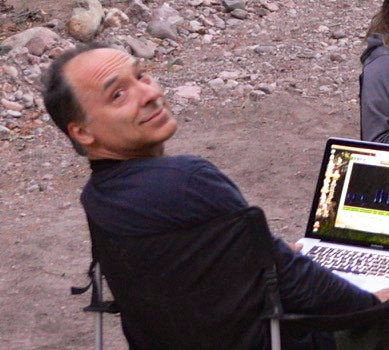Joseph Szewczak Bio

PROFESSIONAL PROFILE
Joe is a Professor of Biological Sciences at Humboldt State University in Arcata, CA, and the developer of SonoBat software to analyze and interpret bat echolocation calls. He began his work with bats investigating their physiological regulation through the differential demands of cold hibernative torpor to the intense demands of flight and high altitude. He has since applied a physiological ecology perspective to conservation and management issues of bats such as roosting, foraging, energetics, and their basic wildlife-habitat associations. He regularly teaches bat biology and acoustic monitoring field classes and workshops throughout the US and abroad. Joe began collecting full-spectrum recordings of bats more than 20 years ago with the notion that they may someday prove useful for identifying bats, and ultimately developed SonoBat to fill the gap he needed to facilitate the specialized tasks of viewing, analyzing, and comparing bat echolocation calls and sequences for non-invasive species recognition.
RELEVANT EXPERIENCE
Professor (2011-present)
Humboldt State University, Arcata, CA.
Research interests include comparative physiology, physiological ecology i.e., the interaction of the organism and its environment, wildlife biology of bats, acoustic analysis of bat echolocation calls, acoustic analysis of bird vocalizations, preventing bat mortality at wind turbines.
Assistant/Associate Professor (2003-2011)
Humboldt State University, Arcata, CA.
Research interests include comparative physiology, wildlife biology of bats, analysis of biological signals, physiological ecology i.e., the interaction of the organism and its environment,
automated acoustic analysis of bat echolocation calls and bird song.
Research Scientist/Development Engineer (1997-2003)
University of California, White Mountain Research Station, Bishop CA
Comparative vertebrate physiology and wildlife biology of bats, extremes of mammalian metabolism, and acid–base regulation in small mammals, managed Station technical infrastructure. Designed and implemented a 19-mile wireless T1 internet link to White Mountain summit (14,246 ft.) capable of withstanding extreme arctic conditions and 200+ mph winds.
Long Term Faculty (1991-1997)
Deep Springs College, Deep Springs CA.
Responsible for the science curriculum for a small, academically intense liberal arts colleges that emphasizes a balanced program of academics, labor, and student self–governance.
EDUCATON
Brown University, Providence RI, 1991
Ph.D. Comparative Physiology
Thesis: Acid–base state and control of breathing in the torpid bat, Eptesicus fuscus; Sigma Xi award for outstanding research by a graduate student.
Duke Univeristy, Durham NC, 1980
B.S.E. Civil Engineering (with emphasis in structural theory)
SELECT PUBLICATIONS AND PRESENTATIONS
Szewczak, J. M. (2011) Acoustic Deterrence of Bats: a Guidance Document. A report submitted to the California Department of Transportation, Sacramento, CA. Agreement No. 43A0219.
Szewczak, J.M. (2011) A call in the night. United States Fish and Wildlife Service Endangered Species Bulletin. 3: 42–43.
Szewczak, J.M., and E.B. Arnett (2008) Field Test Results of a Potential Acoustic Deterrent to Reduce Bat Mortality from Wind Turbines. An investigative report submitted to the Bats and Wind Energy Cooperative. Bat Conservation International. Austin, Texas, USA.
Szewczak, J.M., and E.B. Arnett (2007) Acoustic Monitoring of Bats, in Methods and Metrics for Studying Impacts of Wind Energy Development on Nocturnal Species (Birds and Bats), T.H. Kunz, ed. National Wind Coordinating Committee (NWCC). Journal of Wildlife Management. 71(8): 2449–2486.
Szewczak, J.M., and E.B. Arnett (2006) Preliminary Field Test Results of an Acoustic Deterrent with the Potential to Reduce Bat Mortality from Wind Turbines. An investigative report submitted to the Bats and Wind Energy Cooperative. Bat Conservation International. Austin, Texas, USA.
Szewczak, J.M., and E.B. Arnett (2006) Ultrasound emissions from wind turbines as a potential attractant to bats: a preliminary investigation. An investigative report submitted to the Bats and Wind Energy Cooperative. Bat Conservation International. Austin, Texas, USA.
Szewczak, J.M. (2005) Review: The Indiana Bat, Biology and Management of an Endangered Species. Bat Conservation International, Austin, TX, 253 pp. Journal of Mammalogy. 86(1): 212.
Szewczak, J.M., S.M. Szewczak, M.L. Morrison, and L. Hall (1998) Bats of the White–Inyo Range. Great Basin Naturalist. 58(1):66–75.
Parsons, S., and J.M. Szewczak (2009) Detecting, Recording, and Analyzing the Vocalizations of Bats, in Ecological and Behavioral Methods for the Study of Bats, 2nd Edition, T.H. Kunz, ed. Johns Hopkins University Press (920 pp.).
Szewczak, J.M. (2004) Advanced analysis techniques for identifying bat species. Brigham, R. Mark; Kalko, Elisabeth K.V.; Jones, Gareth; Parsons, Stuart; Limpens, Herman J.G.A. [Eds]. Bat echolocation research: tools, techniques and analysis. Bat Conservation International, Austin. 121–22.
Progress and Limitations of Bat Acoustic Species Classification. Western bat Working Group Meeting, Fort Collins, CO, April 11–14, 2017.
Using Sequential Data Analysis to Assess the Performance and Limitations of Acoustic Species Classifications. Second International Echolocation Symposium, Tucson, AZ, March 25–April 1, 2017.
More Reference Recordings Decreases, Rather than Increases, Acoustic Classification Performance of Myotis sodalis and M. lucifugus. North American Symposium for Bat Research, San Antonio, TX, October 28–31, 2015.
Advanced Analysis Techniques for Identifying Bat Species. International Bat Echolocation Symposium and Tutorial, Austin TX, April 15-17, 2002
BAT-SURVEY AND MONITORING HIGHLIGHTS
2005 – Crew Leader for the SBDN Bat Blitz, Ouachita National Forest, Arkansas, August.
2014 – Forest Canopy Bat Survey for the National Geographic BioBlitz at Golden Gate National Park, March 28-29.
2016 – Surveying Redwood Basal Hollows for Townsend’s Big-eared Bats. California Department of Forestry, Big Basin Redwoods State Park, CA. February 10.
2016 – Surveying Redwood Basal Hollows for Townsend’s Big-eared Bats. California Department of Forestry, Mendocino, CA. December 8.
SELECT TRAINING CLASSES TAUGHT (1996-2017)
2017
“Managing Bat Acoustic Monitoring Data”. USGS Northern Rocky Mountain Science Center, Bozeman, MT, January 9-10.
2016
“Bat Acoustic Monitoring” training workshop. Mojave National Preserve, CSU Desert Studies Center, Zzyzyx, CA. October 2–4.
2015
“Bat Echolocation, Acoustic Monitoring of Bats, and Acoustic Species Discrimination” training for the California Department of Transportation, Sacramento, CA. September 8-10, 2015.
“Bat Echolocation, Acoustic Monitoring of Bats, and Acoustic Species Discrimination” training for the Montana Natural Heritage Program, Beartooth Wildlife Management Area, MT. June 15-17.
“Bat Echolocation, Acoustic Monitoring of Bats, and Acoustic Species Discrimination” training for the Black Hills National Forest, Rapid City, SD. June 8-10.
2013
“Noninvasive Acoustic Monitoring of Bats Using SonoBat Software.” Tirimbina Biological Reserve, Heredia, Costa Rica. September June 22–23, 2013.
2012-2013
“Bat Ecology and Field Techniques Workshop.” The Nature Conservancy Dye Creek Preserve, Los Molinos, CA. April 5–8, 2013.
2009-2012
“Bats and Transportation – Assessment Methods.” Training workshop for Caltrans biologists. Sacramento, CA.
2004-2017
“Bat Acoustic Data Management”, “Acoustic Survey Methods””, and Combined Field Survey Techniques Workshops” for Bat Conservation International, Inc.; Bat Conservation and Management, Inc.; and Bat Survey Solutions, LLC at field venues in Arizona, California, Florida, Illinois, Indiana, Kentucky, Maine, Minnesota, New York, Pennsylvania, and Tennessee.
2004-2014
“Field Techniques Workshops”, “Noninvasive Acoustic Monitoring of Bats”, and “Physiological Ecology and Acoustic Monitoring of Bats” training classes for The Wildlife Society at locations throughout California.
2003 - 2010
Training Workshops for the Pacific Northwest Bat Grid, Oregon Bat Grid, and USDA Forest Service Bat Grid about the “Physiological Ecology, Echolocation and Acoustic Monitoring of Bats” at over a dozen locations in Montana, Oregon, and Washington.
1996-2016
Annual Summer Workshops on “The Ecology and Conservation of California Bats” at the San Francisco State University Field Campus.
